
Terms you will learn:
SCSI
SCSI ID Numbers
Internal & External
Hard Disks
SCSI termination
Hard drive Software setup
IDE Drive
Disk First Aid
Designating
a Startup Disk
Initializing
a New Hard Disk
SCSI (Small Computer System Interface) (pronounced "scuzzy")
SCSI is a computer port which allows external devices to be attached to the Mac. An Apple SCSI chain can have up to 7 devices. SCSI devices include hard drives, CD-ROM drives, printers, scanners, and Mac systems.

A Mac desktop computer system is considered a SCSI device. The internal hard disk of a Mac desktop computer is considered a SCSI device. You can connect a maximum of 6 external SCSI devices to a Mac if it has an internal SCSI hard drive.
The peripheral devices on a SCSI network that have terminators attached (the first and last devices) must be turned on to pass information through the cable system.
SCSI ID Numbers
Each SCSI device must have its own unique ID
or priority number. The ID number determines the device's place in the
chain. SCSI ID 0 represents the first device. The desktop Mac system
is always assigned a SCSI ID of 7. If there is an internal hard drive,
it is usually assigned a SCSI ID of 0.
Apple Mac Quadra and Power Mac computers can have multiple internal SCSI devices, If the system has an internal CD-ROM drive, which is usually set to SCSI ID 3 at the factory, as indicated in the graphic.
Internal & External
Hard Disks
Internal and external hard disks differ in two
significant ways:
oInternal
hard disk assemblies have built-in terminators (resistor packs). Some external
hard disks do not have built-in terminators.
oOn Apple internal
hard drive assemblies, the SCSI ID number is factory set at 0. On external
hard disks, the SCSI ID can be set by the user.
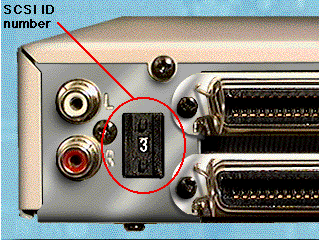
The maximum length of a SCSI network is 20 feet.
SCSI networks longer than 20 feet are prone to disk and booting problems.
SCSI termination
Terminators are required to ensure signal integrity
along a SCSI bus, which connects hard disks and other peripherals. They
control voltage range and keep signals from bouncing off one end of the
bus and rippling back, interfering with new messages. Improper termination,
or no termination at all causes many SCSI system problems.

If the SCSI bus consists of only the Mac (without an internal hard disk) and one external hard disk, you need only one terminator.
Any SCSI bus that consists of the Mac computer and more than one external hard disk must be terminated at each end. If the Mac computers have an internal hard disk, the disk is internally terminated.

A SCSI chain should never have more than two terminators. A SCSI chain with more than two terminators may cause intermittent problems or inhibit booting.
One of the terminators is always at the beginning of the chain, either inside the computer or between the system cable and the first SCSI drive.
The second terminator is always at the end of the chain, either inside the last SCSI device or attached to a SCSI port on the last device.
Some devices are internally terminated, as shows
in the graphic. Internal terminators must be counted when determining how
many terminators are needed.

Hard Drive Software
setup
Both floppy disks and hard disks can become damaged
from repeated use and handling. The Mac system software provides some tools
for testing drives and repairing some types of damage or wear.
If you see a message that says a disk is unreadable or damaged, the following programs may help to diagnosed repair the problem: Disk First-Aid, Apple HD SC Setup, and Drive Setup Utility.
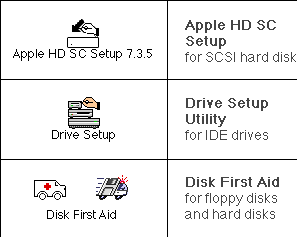
Depending on the model of the Mac, you can use Apple HD SC Setup or Drive Setup to initialize, mount, update, and test some Apple-qualified SCSI storage devices.
Formatting an IDE Drive
IDE (Integrated Drive Electronics) hard drives
are a new type of drive that are a lower-cost alternative to SCSI based-drives.
The IDE drives are placed in selected Macs, including those shown on the
list below.
Newer version of Apple HDSC Setup may work when formatting an IDE drive, if not, you can format an IDE drive with Drive Setup Utility.
Some Mac computers with IDE drives include: Mac LC 580, Mac LC 630, Quadra 630, Peforma 630, Power Mac 5200/75 LC, Performa 6200, Performa 5300, Performa 6300, and Power Mac G3.
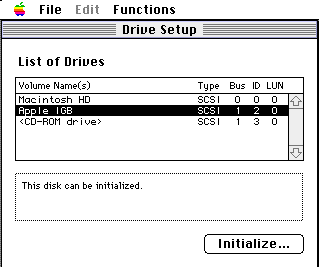
When formatting an IDE internal hard disk, be sure to use either Internal HD Format or Drive Setup Utility. Drive Setup Utility, which originally shipped with System 7.5.2, has replaced Internal HD Format, but you may be able to use Internal HD format if your computer included it originally. If Internal HD Format does not work, use Drive Setup instead. Drive Setup is supported on all Power Macs (original and PCI-based) and on 68040 based desktop computers that have IDE drives installed.
The first IDE drives installed on Macs were initialized without partitioning information. Drives that show "Where: Macintosh HD_AT0" in the Get Info window are such drives. IDE drives partitioned with Drive Setup include partition information in the Get Info window. This is why Apple’s Internal HD Format 1.x utility does not recognize these newer IDE drives.
When an IDE volume is selected in Drive Setup 1.0 or later, the application looks for partition information on the IDE drive. If it finds this partition information, the option to update the drive’s ATA driver is available. If partition information is absent, you must reintialize the hard drive to properly format it to include this partition information.
Disk First Aid
Disk First Aid helps you regain the use of an
apparently damaged disk without destroying the information and programs
stored there. Disk First Aid can examine and verify that your disk is OK,
and it can repair damaged data structures.
Disk First Aid can verify but not repair the following: the startup disk, the Disk First Aid disk, a write-protected disk, a disk with open files, and any disk when File Sharing is active.
To use Disk First Aid
1. Double-click the Disk First Aid icon to open
the application. The application opens and presents a dialog box from which
you can select a disk.
2. Select a disk to verify.
3. Click Verify to test the disk
4. Click Repair to repair disk.
5. When testing and repair are completed, choose Quite from the File menu. Or, if you want to test another disk, choose Close from the File menu, then select and open another disk (as in Step 2), and repeat Steps 3 and 4.
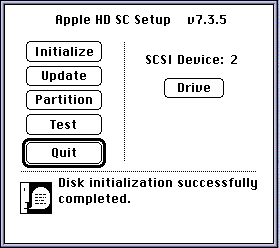
If Disk First Aid does not fix the problem, try
one of the following measures:
o Use Disk First Aid two or three more times
with the faulty disk. Repeating this process occasionally corrects the
problem.
Use another disk recover program with the faulty disk. For example, Norton's Disk Doctor is a good one.
Consult a technician or other specialists for help.
Give up and erase (reinitialize) the disk. If this doesn't work, then discard the damaged disk.
Designating
a Startup Disk
Most users configure one hard drive as a startup
device. This means that the hard drive contains the system software that
the computer requires at startup.
Users can store all their applications and files
on the hard drive, and launch applications directly from the hard drive.
If a Mac system has more than one hard drive containing startup information,
you can use the Startup Disk control panel to designate the preferred startup
disk.
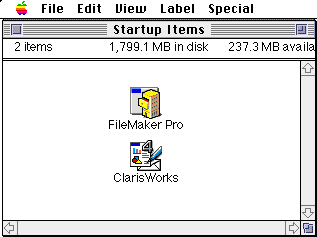
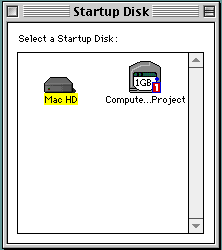
Initializing
a New Hard Disk
Before you can use a new disk, you need to initialize
or format the disk. Initializing a disk
erases any information on it.
The internal hard disks in many Macs are prepared at the factory. These drives do not have to be initialized before you use the computer. If the hard disk in your computer has been initialized, you'll see the disk's icon on the desktop when you first turn on the computer.
If you have a new hard disk connected to your system, but don't see the hard disk's icon on your desktop when you start up your Mac, you'll need to initialize the disk to prepare it to store information.
To initialize a new hard disk:
1. Double-click the Apple HD SC Setup program
icon to launch it.
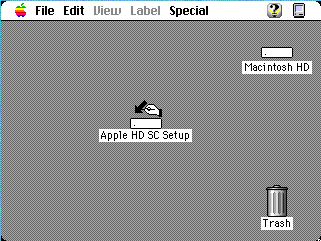
2. If necessary, click the Drive button to select the disk you want to initialize. The selected disk's SCSI ID number appears above the Drive button. The ID number of an internal hard disk is 0.
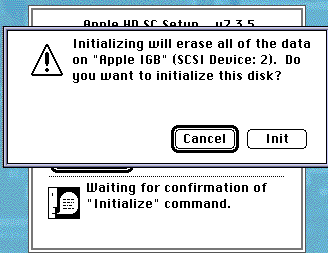
3. When the number (and name, if any) of the hard
disk you want is displayed, click Initialize to begin. Note:
You cannot initialize the disk that contains the Apple HD SC Setup application.
4. Click Init to initialize the hard disk.
A dialog box reports the status of initialization, If you see a report that initialization has failed, begin the process again. If the disk has been initialized previously, this dialog box does not appear.
5. After successful initialization, you will be
asked to name the disk. Type the name of the hard disk and click
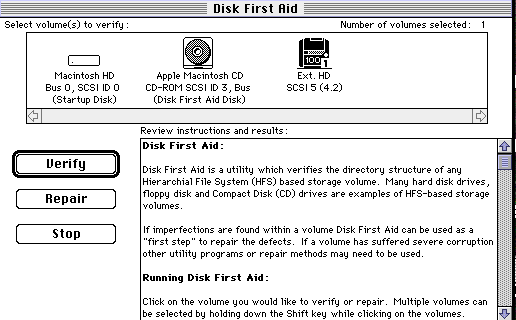
6. Click Quit to exit the Apple HD SC Setup application
or click Drive to select another hard disk to initialize.
Startup from an External Hard Drive
In some cases, the internal hard disk (SCSI ID
0) may have a damaged System Folder.
In order to skip the faulty System Folder on the internal hard disk and startup from a good system on an external hard drive, do the following:
1. Turn on the computer, or choose Restart from the Special menu.
2. Hold down the Command-Option-Shift and Delete
keys. Release the keyboard keys when you see the LED light on the
external hard disk blink on and off a few times.
You may also startup from a CD-ROM which has
a system folder by doing the following:
1. Insert the CD in the CD holder;
2. Restart the computer;
3. When the computer starts to boot up hold down the letter c on the keyboard. This tells the computer to go to the CD to look for the system folder.